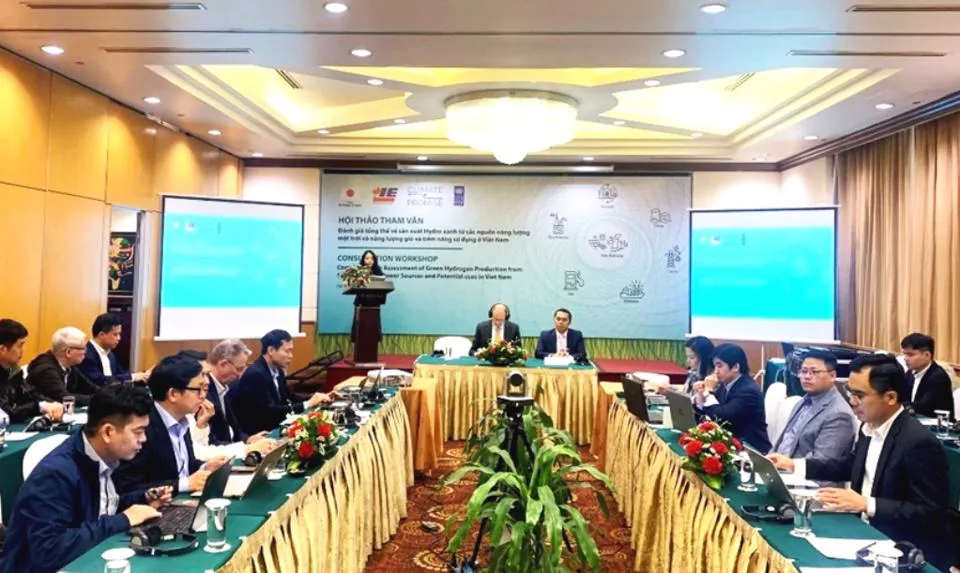Green hydrogen: Key to carbon-free economy in Vietnam
Experts said that efforts to build a cohesive national strategy for Vietnam must occur sooner than later.
Green hydrogen and its derivatives are expected to be a solution that occupies an increasingly important position in the energy transition path in Vietnam thanks to its superior properties in reducing carbon dioxide emissions.
| Overview of the workshop on the role of green hydrogen in Vietnam's economy takes place in Hanoi on Feb 23. Photo: UNDP |
Deputy Head of the Institute of Energy Le Van Cuong shared the view at a consultation workshop on Comprehensive Assessment of Green Hydrogen Production from Solar and Wind Power Sources and Potential Uses in Vietnam held today [Feb 23] in Hanoi in collaboration with the United Nations Development Program (UNDP).
Cuong said green hydrogen is vital, whether as a fuel for energy conversion or as an input for industrial production.
Green hydrogen is considered a new generation energy source, an optimal alternative energy source in the near future.
According to Nguyen Xuan Trung from the Ministry of Industry and Trade's Institute of Energy, the production of green hydrogen and energy carriers such as ammonia together with renewable energy plants can partially meet Vietnam's demand for energy storage and consumption in transportation and other sectors (industrial, oil refinery).
He said green hydrogen is used in different sectors in Vietnam, such as cement and metal, in factories like an oil refinery and fertilizer production, and in transportation and power generation.
UNDP Deputy Resident Representative, Patrick Haverman, said green hydrogen has broad application uses, which include but are not limited to shipping, transportation, steel, fertilizers, and chemicals, many of which are sectors that are difficult to decarbonize.
Its production remains novel in Vietnam, but the energy medium has garnered interest. Notably, Vietnamese company TGS Green Hydrogen is poised to build the country's first electrolyzer with an $840 million investment, signaling that efforts to create a cohesive national strategy must occur sooner than later.
Accordingly, the joint UNDP-Institute of Energy study takes the preliminary steps to assess the potential role of green hydrogen production from water electrolysis, the use of green hydrogen to reduce greenhouse gas emissions on a large scale and accelerate the clean energy transition in Vietnam.
Preliminary findings include economic and statistical analysis using the most up-to-date data on domestic electricity and renewable electricity projections, utilizing assumptions from IRENA, IEA, and the 2021 Vietnam Energy Outlook.
These projects provide estimates for Vietnam's current and future green hydrogen and ammonia demand, a discussion on the national policy and legislative framework for green hydrogen development, and compare against global results in use and policy, said the UNDP official.
High demand for green hydrogen
With economic growth of more than 8% in 2022, Vietnam’s rapidly growing economy with a robust industrial process is in high demand for energy. Its energy consumption increases by 10-12% per year.
According to Patrick Haverman, energy remains the largest contributor, estimated to represent about 70% of Vietnam’s total emissions by 2030. The government has recognized the serious threat of climate change, as exemplified by its commitment to achieving net zero by 2050 at COP26, quadrupling its solar and wind capacity since 2019, and the announcement of a $15.5 billion Just Energy Transition Partnership (JETP) with a coalition of international partners (G7).
In this context, the Government of Vietnam has set a series of JETP commitments to reduce its peak annual power sector emissions by up to 30% and bring forward the peaking date by 5 years, increasing the share of renewables in electricity generation to at least 47% by 2030 from 36%, revising down Vietnam’s peak coal capacity, and peaking all emissions in 2030 rather than 2035.
“The successful delivery of these targets will also entail a small, but meaningful role from green hydrogen, which will grow in the coming years,” Haverman stated.
To address the potential for hydrogen production from water electrolysis in Vietnam, UNDP highlighted three key elements for next discussions. It includes providing a realistic estimate of green hydrogen, three different scenarios were developed based on a fully decentralized solar and wind generation, the provision of renewable electricity from a supplied utility, and the mixed provision of grid electricity and some dedicated onshore wind and solar power.
In addition, the levelized cost of hydrogen is projected to decline markedly in each of the three scenarios. And it is important to highlight the role of the government in setting targets, developing strategies, and providing market-based incentives towards decarbonization.









